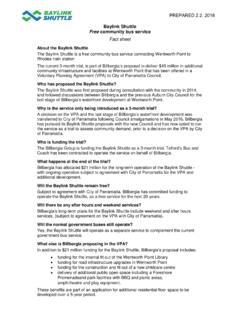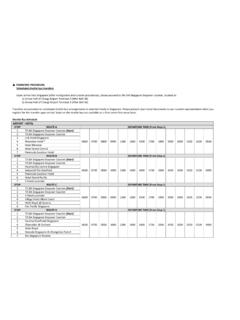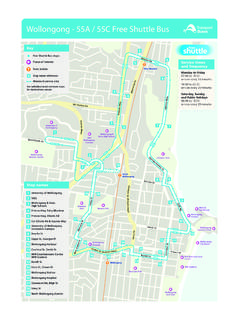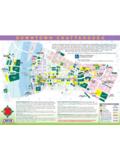Transcription of This learning activity is prepared for students to …
1 1 PHOTO CREDIT: NASANextSpace shuttle InformationThis learning activity is prepared for students to explore and learn about the Space shuttle . 2 The purpose of this presentation is to:1. teach valuable information about the Space shuttle and the systems that make up each of its three main components2. prepare students for an interactive shuttle launch simulation3. increase students ability to navigate, locate, and record specific information using various computer media4. open the door to a variety of in-depth studies of related math, science, and technology conceptsNextPurpose3 The Space shuttle as we know it today is made up of three unique components.
2 Each component serves a very important role in helping the Space shuttle reach its orbit in space. To the left, you see a drawing of the Space shuttle and its three main components. 1. ET- External Tank2. SRB - Solid Rocket Booster3. OV- Orbiter VehicleAs part of the new employee orientation, you will need to know all about the shuttle components. Using the navigation buttons, select one of the components to find out more detailed information about that component and its specific systems. When you have learned as much as you can, navigate back to this page and choose a different TankOrbiterPurposeThe Space ShuttleNextThe Space shuttle as we know it today is made up of three unique components.
3 Each component serves a very important role in helping the Space shuttle reach its orbit in space. To the left, you see a drawing of the Space shuttle and its three main components. 1. ET-External Tank2. SRF-Solid Rocket Booster3. OV-Orbiter VehicleAs part of your new employee orientation, you will need to know all about the shuttle components. Using the navigation buttons, select one of the components to find out more detailed information about that component and its specific systems. When you have learned as much as you can, navigate back to this page and choose a different component. 4 The orbiter is the manned spacecraft of the Space shuttle s three main components.
4 It can transport into near earth orbit (115 to 690 miles from the earth s surface) cargo weighing up to 56,000 pounds, and it can return with up to 32,000 pounds. this cargo, called payload, is carried in a bay 15 feet in diameter and 60 feet long. The major structural sections of the orbiter are: the forward fuselage, which contains the pressurized crew compartment the mid fuselage, which contains the cargo bay the aft fuselage, from which the main engine nozzles project the vertical tail, which serves as a speed brake used during entry and landingChallengerDiscoveryAtlantisEndeav ourNextThe OrbiterNextThe major structural sections of the orbiter are the forward fuselage, which contains the pressurized crew compartment; the mid fuselage, which contains the cargo bay; the aft fuselage, from which the main engine nozzles project.
5 And the vertical tail, which splits open along the trailing edge to provide a speed brake used during entry and landing. The crew compartment is divided into two levels, the flight deck on top and the middeck below. The flight deck includes all flight controls used for launch, orbital trajectory corrections, rendezvous operations, and landing. The middeck middeck provides the crew's working, eating, and sleeping environment. It also houses the electronic, guidance, and navigation systems. The orbiter normally carries a flight crew of four with three additional passengers. A total of 10 people could be carried under emergency conditions. The basic mission is seven days in space, but with additional supplies, a 30 day mission is crew compartment is divided into two levels, the flight deck on top and the middeck below.
6 The flight deck includes all flight controls used for launch, rendezvous operations, and landing. The middeck provides the crew's working, eating, and sleeping environment. It also houses the electronic, guidance, and navigation systems. The orbiter normally carries a flight crew of up to 7, but a total of 10 people could be carried under emergency conditions. ColumbiaChallengerDiscoveryAtlantisEndea vourThe OrbiterNextThe crew compartment is divided into two levels, the flight deck on top and the middeck below. The flight deck includes all flight controls used for launch, orbital trajectory corrections, rendezvous operations, and landing. The middeck provides the crew's working, eating, and sleeping environment.
7 It also houses the electronic, guidance, and navigation orbiter normally carries a flight crew of four with three additional passengers. A total of 10 people could be carried under emergency conditions. The basic mission is seven days in space, but with additional supplies, a 30 day mission is Space shuttle orbiter has three main engines weighing 7,000 pound each. They are very sophisticated power plants that burn liquid hydrogen with liquid oxygen, both from the external tank (ET). The main engines are located in the aft (back) fuselage (body of the spacecraft). They are used for propulsion during launch and ascent in to space with the aid of two powerful solid rocket boosters (SRBs).
8 The main engines provide 29% of the thrust needed to lift the shuttle off the pad and into orbit. Each engine can generate almost 400,000 pounds of thrust at EnginesNextThe Space shuttle orbiter has three main engines weighing 7,000 pound each. They are very sophisticated power plants that burn liquid hydrogen with liquid oxygen, both from the external tank (ET). The main engines are located in the aft (back) fuselage (body of the spacecraft). They are used for propulsion during launch and ascent in to space with the aid of two powerful solidrocket boosters (SRBs). The main engines provide 29% of the thrust needed to lift the shuttle off the pad and into engine can generate almost 400,000 pounds of thrust at the shuttle accelerates, the main engines burn a half-million gallons of liquid propellant provided by the ET.
9 The main engines burn liquid hydrogen (LH2) -- the second coldest liquid on Earth at -423 degrees Fahrenheit (minus degrees Celsius) -- and liquid propellants are liquid oxygen (LOX), which serves as an oxidizer, and liquid hydrogen (LH2), which is a gaseous form, oxygen and hydrogen have such low densities that extremely large tanks would be required to store them aboard a rocket. But cooling and compressing them into liquids vastly increases their density, making it possible to store them in large quantities in smaller the shuttle accelerates, the main engines burn a half-million gallons of liquid propellant provided by the ET. The main engines burn liquid hydrogen (LH2) -- the second coldest liquid on Earth at -423 degrees Fahrenheit (minus degrees Celsius) -- and liquid propellants are liquid oxygen (LOX), which serves as an oxidizer, and liquid hydrogen (LH2), which is a gaseous form, oxygen and hydrogen have such low densities that extremely large tanks would be required to store them aboard a rocket.
10 But cooling and compressing them into liquids vastly increases their density, making it possible to store them in large quantities in smaller tanks. 8 Oxidizer from the external tank enters the orbiter's main propulsion system liquid oxygen feed line. Here it branches out into three parallel paths, one to each engine. In each branch, a liquid oxygen prevalve must be opened to permit flow to the low-pressure Pressure Oxidizer Turbopump (LPOT) is an axial-flow pump driven by a six-stage turbine powered by liquid oxygen. The flow from the LPOT is supplied to the High-Pressure Oxidizer Turbopump (HPOT). The HPOT consists of a main pump and a preburner pump.




![Untitled-1 [www.miami-airport.com]](/cache/preview/a/6/6/4/e/3/2/a/thumb-a664e32aa7cef4c29ae356ee62c18f38.jpg)

